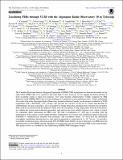Localizing FRBs through VLBI with the Algonquin Radio Observatory 10 m Telescope
Author(s)
Masui, Kiyoshi
DownloadPublished version (4.389Mb)
Publisher with Creative Commons License
Publisher with Creative Commons License
Creative Commons Attribution
Terms of use
Metadata
Show full item recordAbstract
<jats:title>Abstract</jats:title>
<jats:p>The Canadian Hydrogen Intensity Mapping Experiment (CHIME)/FRB experiment has detected thousands of fast radio bursts (FRBs) due to its sensitivity and wide field of view; however, its low angular resolution prevents it from localizing events to their host galaxies. Very long baseline interferometry (VLBI), triggered by FRB detections from CHIME/FRB will solve the challenge of localization for non-repeating events. Using a refurbished 10 m radio dish at the Algonquin Radio Observatory located in Ontario Canada, we developed a testbed for a VLBI experiment with a theoretical <jats:italic>λ</jats:italic>/<jats:italic>D</jats:italic> ≲ 30 mas. We provide an overview of the 10 m system and describe its refurbishment, the data acquisition, and a procedure for fringe fitting that simultaneously estimates the geometric delay used for localization and the dispersive delay from the ionosphere. Using single pulses from the Crab pulsar, we validate the system and localization procedure, and analyze the clock stability between sites, which is critical for coherently delay referencing an FRB event. We find a localization of ∼200 mas is possible with the performance of the current system (single-baseline). Furthermore, for sources with insufficient signal or restricted wideband to simultaneously measure both geometric and ionospheric delays, we show that the differential ionospheric contribution between the two sites must be measured to a precision of 1 × 10<jats:sup>−8</jats:sup> pc cm<jats:sup>−3</jats:sup> to provide a reasonable localization from a detection in the 400–800 MHz band. Finally we show detection of an FRB observed simultaneously in the CHIME and the Algonquin 10 m telescope, the first non-repeating FRB in this long baseline. This project serves as a testbed for the forthcoming CHIME/FRB Outriggers project.</jats:p>
Date issued
2022-02-01Department
MIT Kavli Institute for Astrophysics and Space Research; Massachusetts Institute of Technology. Department of PhysicsJournal
The Astronomical Journal
Publisher
American Astronomical Society
Citation
Masui, Kiyoshi. 2022. "Localizing FRBs through VLBI with the Algonquin Radio Observatory 10 m Telescope." The Astronomical Journal, 163 (2).
Version: Final published version